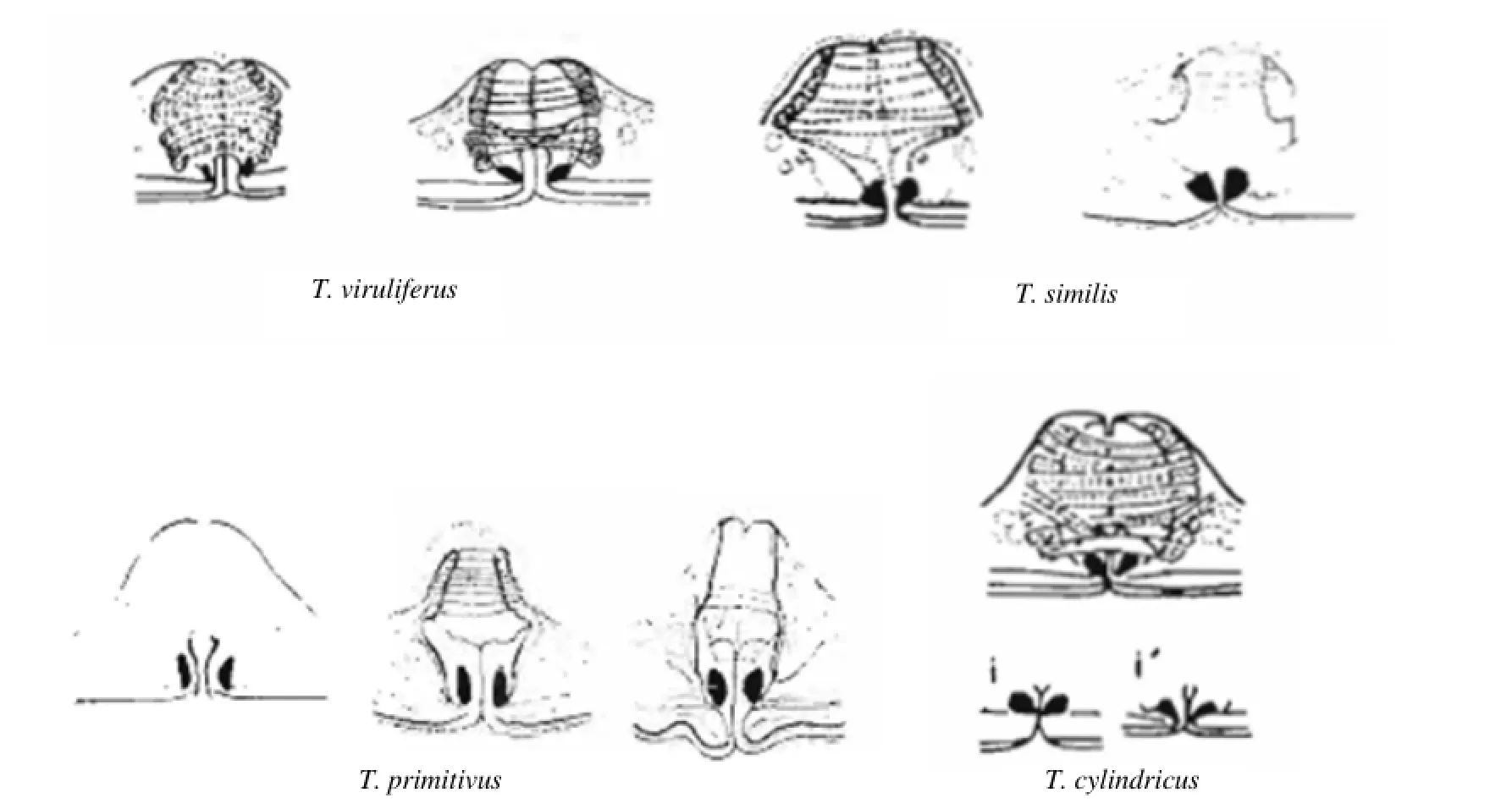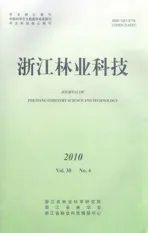毛刺属线虫传毒种及其研究进展
2010-05-09陈吴健林晓佳
陈吴健,吴 蓉,林晓佳
(浙江出入境检验检疫局,浙江 杭州 310012)
毛刺属线虫传毒种及其研究进展
陈吴健,吴 蓉,林晓佳
(浙江出入境检验检疫局,浙江 杭州 310012)
摘要:介绍了毛刺属线虫的圆桶毛刺线虫(Trichodorus cylindricus)、原始毛刺线虫(T. primitivus)、具毒毛刺线虫(T. viruliferus)、相似毛刺线虫(T. similis)4种传毒线虫种类,综述了这4种传毒种毛刺属线虫传毒的专化性、形态学鉴定、分子生物学鉴定的研究进展,并提出了检疫部门今后的研究重点是为一线人员提供快速、精确、灵敏的检疫方法。
关键词:毛刺线虫;传毒种;专化性;鉴定技术
毛刺线虫在世界大部分地区都有报道发生,并广泛分布于欧洲、南、北美洲,通过直接取食或传播植物病毒,严重危害多种栽培作物和野生植物[1](见表1),其中传播病毒造成损失远远大于线虫本身取食造成危害,因此其作为传毒线虫引起了各国的重点关注。我国于2007年5月正式对外公布的进境植物检疫性有害生物名单中,包含了所有的传毒线虫种类,其中就包括毛刺属线虫传毒种。
1 毛刺属线虫传毒种及其所传病毒
Trudgill[2]提出了长针科线虫作为病毒介体必须符合一系列标准:①病毒和线虫的特征必须能够准确的鉴定;②试验表明诱饵植物组织为病毒侵染;③试验中介体线虫的种是唯一可能的介体。Brown等[3]根据Trudgill对已报道的毛刺线虫或拟毛刺线虫传毒文献进行的评价,发现40篇中,只有12篇完全符合标准,随后提出用单个毛刺线虫测定其传毒的新方法,给评价毛刺线虫传毒提供了可行的方法,该方法完全符合Trudgill提出的标准。经过研究,Brown等[4]提出毛刺属只有4种线虫能够传毒,分别为:圆桶毛刺线虫(Trichodorus cylindricus)、原始毛刺线虫(T. primitivus)、具毒毛刺线虫(T. viruliferus)、相似毛刺线虫(T. similis)。
毛刺科线虫传播的病毒为烟草脆裂病毒属(Tobravirus)病毒。烟草脆裂病毒属病毒为杆状粒体,共有3个确定种,其中草脆裂病毒(Tobacco rattle virus,TRV)、豇豆早褐病毒(Pea early-browning virus,PEBV)两种由毛刺属线虫传播,辣椒环斑病毒(Pepper ringspot virus,PRV)由拟毛刺属线虫传播[5~7]。

表1 毛刺属线虫传毒种的地理分布和寄主范围[10]Table 1 Geological distribution and host range of virus-vector ofTrichodorusnematodes
2 毛刺属线虫传毒专化性
2.1 毛刺属线虫与所传病毒的专化性组合
毛刺线虫种与传播的病毒种或株系之间具有高度的专化性水平,可达到介体种的不同种群或微小差异的病毒血清型株系上的专化性程度[5,8~9](见表2)。

表2 毛刺属线虫种与植物病毒间专化性组合[5]Table 2 Specificity ofTrichodorusspecies with plant viruses
2.2 毛刺属线虫的传毒机理
毛刺线虫所传带病毒被吸附在整个食道壁及食道和肠连接的瓣门上,但是在毛刺上没有病毒粒体[10]。线虫对病毒粒体的保留和释放,有两种假说:
电荷假说:线虫的病毒保留位点和病毒粒体各带有不同电荷,通过正负电荷吸引而使粒体保留在有效位点,一种病毒的不同株系可能表面带有的电荷密度不同,就需要不同介体线虫种来传播;而不同病毒种如能由同一介体线虫种传播,则可能是因为病毒具有相似的电荷密度。据推测,病毒粒体的释放可能是在线虫取食时食道腔内的pH值发生变化,从而改变粒体表面电荷、释放粒体[5~6]。
分子识别假说:毛刺线虫食道内壁层上具有碳水化合物粘层,而病毒外壳蛋白(CP)可能具有类似凝集素的特性,二者之间存在分子识别关系而进行结合,病毒粒体的传播可能依赖于病毒蛋白外壳的特性[5~6]。
2.3 毛刺属线虫传毒专化性的分子机制
试验表明,病毒基因组RNA-2片断在线虫传播中起了重要作用[7]。RNA-2片断编码病毒外壳蛋白和1~3种非结构蛋白[11~12]。核磁共振研究表明,烟草脆裂病毒属病毒外壳蛋白C一末端具有一突出粒体表面的片断,可能与病毒粒体在介体内的保留位点起作用[5,13~14]。
原始毛刺线虫可传播PEBV-TpA56,但不能传播PEBV-SP5株系。分析2个株系RNA-2编码的3种分子量分别为9、29.6、23 ku的非结构蛋白发现,编码29.6 ku蛋白的基因与线虫传播有关[15]。Macfarlane等[16]通过诱变试验发现,PEBV-TpA56所有非结构基因可能都与线虫介体传播有关,Schmitt等[17]在随后的诱变试验中发现,23 ku基因不是线虫传播的必要条件,但影响线虫传播频率。Macfarlane[13]的研究表明非结构蛋白基因还和线虫传播的专化性有关。
3 毛刺属线虫传毒种鉴定的研究进展
3.1 形态学研究
3.1.1 毛刺属的研究[10]由于毛刺科线虫的雌雄虫都具有丰富的形态分类特征,所以雌雄虫的形态特征都被用于种属的鉴定。毛刺属雌虫以生殖腺的单双、受精囊的有无、阴道长度、阴道骨化结构的大小、阴道收缩肌的发达程度、阴门形态、阴门区侧体孔的有无等分类特征,区分于毛刺科其他各属。毛刺属雄虫的鉴定则主要根据交合伞的有无、虫体后部的弯直、交合刺悬肌囊的发达程度、交配乳突数、交合刺形态及饰纹附属物、缩回交合刺区内交配乳突数、颈乳突数、侧颈孔数等特征。
3.1.2 毛刺属4个传毒种的形态学研究 Decraemer[10]对毛刺属的种的鉴定特征进行了详细描述,对4种传毒毛
刺线虫的雌雄虫特征描述如下:
3.1.2.1 雌虫特征
原始毛刺线虫:阴道骨化结构杆状,间距宽,平行于阴道腔;瘤针长28~57μm。
具毒毛刺线虫:阴道骨化结构杆状,但较短、近卵形,间距宽,平行于阴道腔;阴道长菱形;瘤针长28~57 μm。
相似毛刺线虫:阴门横裂;阴道长菱形;阴道骨化结构略小,不平行于体纵轴线,圆三角形,相距近;一个阴门后侧体孔;瘤针长36~52μm。
圆筒毛刺线虫:阴道桶形;阴道骨化结构中等大小,不平行于体纵轴线,三角形,其顶端指向阴门、倾斜;瘤针长35~52μm。
3.1.2.2 雄虫特征
原始毛刺线虫:有3个腹中颈乳突,瘤针区内有2个,第二个正好位于瘤针基部后;缩回交合刺区有1个腹中交配乳突;交合刺杆部的后半部非常细,交合刺中部的缢缩有时不清楚,刚毛有时不清楚,交合刺长32~54μm。

图1 4种传毒毛刺属线虫的雄虫交合刺形态Figure 1 Spicule morphology of 4 maleTrichodorusnematodes

图2 4种传毒毛刺属线虫的雌虫阴门及阴道骨化结构形态Figure 2 Vulva and vaginal sclerotization of 4 femaleTrichodorusnematodes
具毒毛刺线虫:有3个腹中颈乳突,位于瘤针区内有2个,第二个正好位于瘤针基部后;缩回交合刺区无腹中交配乳突;交合刺较细,中间较短的有缺刻区,刚毛不明显,交合刺长22~37μm;瘤针长32~53μm。
相似毛刺线虫:有3个腹中颈乳突,位于瘤针区内有1个;交合刺有球形柄,粗,长30~44μm;瘤针长35~50μm。
圆筒毛刺线虫:有3个腹中颈乳突,位于瘤针区内有1个;虫体后部直,有交合伞;交合刺杆的后部膨大,交合刺无球形柄,长28~49μm。
3.2 毛刺属线虫传毒种的分子鉴定
毛刺线虫种的形态学鉴定,要求鉴定人员具有良好的分类学基础。分子生物学在其它线虫的鉴定中已得到广泛应用[19~21],但是在毛刺属线虫的鉴定中应用很少。Boutsika等[22]对来自两个毛刺属和拟毛刺属的四个种(Paratrichodorus macrostylus, P. pachydermus, T. primitivus和T. similis)的rDNA序列特征进行了分析,发现其18S和5.8S基因高度保守,相反的,ITS序列的变异度比较大。T. primitivus和T. similis的ITS序列长度分别为1537 bp和1 303 bp,是线虫门中已报道最长的ITS序列,是拟毛刺属两个种的2~3倍,但是GC含量没有显著性差异。
在之后的研究中,Boutsika等[23]设计了针对P. macrostylus、P. pachydermus、T. primitivus和T. similes4个种的特异性引物,并成功运用单条成虫的DNA完成了PCR扩增,获得的PCR产物大小依次为:497、329、256、452 bp。传毒线虫种的特异性引物,结合该线虫所传播的TRV病毒株的特异性引物一并扩增,被用来检测地块传播TRV病毒的可能性。
Holeva[24]设计了一套基于实时荧光PCR技术的检测传毒毛刺线虫与其所传病毒的方法。针对P. macrostylus、T. similis的18S基因分别设计了特异性引物和探针,同时分别针对TRV的RNA1、TRV-Ppk20和TRV-Tpo120毒株的RNA2设计了3对引物和探针,并成功完成了单一样品的试验;希望运用该方法通过对地块土样的检测,快速、灵敏、准确获得该地块内线虫病毒的种类、数量等分子信息,为该地块的风险评估提供可靠的依据。
4 问题和展望
针对四种传毒毛刺属线虫,无论是传毒的分子机理,还是分子生物学鉴定,主要是由Brown等专家研究,但近几年未有新的报道;其次关于T. primitivus和T. similis研究的相对较多,但对圆桶毛刺线虫、具毒毛刺线虫的研究几乎为空白。针对T. primitivus和T. similis的特异性引物已有报道,但是同时检测多种线虫的PCR方法有待开发。Boutsika等[23]报道其设计的T. similis引物的PCR结果不稳定,并怀疑所用的DNA提取方法不适用于T. similis,其提取方法有待改良。T. cylindricus、T. viruliferus的传毒机理、传毒专化性的分子机理等是否与T. primitivus、T. similis类似,有待进一步研究。作为检疫部门,探索T. cylindricus、T. viruliferus是否也存在与T. primitivus、T. similis一样变异度较大的ITS区,设计鉴定种的特异性引物,为一线人员提供快速、精确、灵敏的检疫鉴定方法,是今后研究工作的重点。
参考文献:
[1] Brown D J F. The transmission of two strains of strawberry latent ringspot virus by populations of Xiphinema diversicaudatum (Nematoda: Dorylaimoidea[J]. Nematol,1985(13):217-223.
[2] Trudgill D L,Brown D J F. Mcnamara D G. Methods and criteria for assessing the transmission of plant viruses by longidorid nematodes[J]. Revue Nematol,1983,6(1):133-141.
[3] Brown D J F,Ploeg A T,Robinson D J. A review of reported associations between Trichodorus and Paratrichodorus species (Nematoda:Trichodoridae) and tobraviruses with a description of laboratory methods for examining virus transmission by trichodorids[J]. Revue Nematol,1989,12(3):235-241.
[4] Brown D J F,Halbrendt J M,Jones A T,et a1. An appraisal of some aspects of the ecology of nematode vectors of plant viruses[J]. Nematologia mediterraneum,1994(22):253-263.
[5] Brown D J F, Robinson W M,Trudgill D L. Transmission of viruses by plant nematodes[J]. Annu Rev Phytopathol,1995(33):226.
[6] Brown D J F,Weischer B.Specificity,exclusivity and complementarity in the transmission of plant viruses by plant parasitic nematodes:an annotated tern1inology[J]. Fundam Appl Nematol,1998(21):1-11.
[7] Vassilakos N ,Macfarlane S A ,Weischer B,et a1. Exclusivity and complementarity in the association between nepo—and tobraviruses and their respective vector nematodes[J]. Med Fac Landbouww Univ Gent,1997(62):713-720.
[8] Brown D J F,Ploeg A T,Robinson D J. The association between serotypes of tobraviruses and Trichodorus and Paratrichodorus species[J]. Bulletin OPPE/EPPO Bulletin,1989(19):611-677.
[9] Ploeg A T,Asjes C J,Brown D J F. Tobacco rattle virus serotypes and associated nematode vector species of Trichodoridae in the bulb-growing areas in the Nether1ands[J]. Neth J PI Path,1991(97):311-319.
[10] Decraemer W. The family Trichodofidae:stubby root and virus vector nematodes[M]. The Netherlands, Kluwer acdemic pubhshers,1995,27-31,77-337.
[11] Brown D J F,Trudgill D L,Robinson W M. Nepoviruses:transmission by nematodes[A]. HARRISON,MuRANT A F. The PIant Viruses(Vol 5)[M]. New York:Plenum Press,1996,187-209.
[12] Ploeg A T,Brown D J F,Robinson D J.The association between species of Trichodorus and Paratrichodorus vector nematodes and serotypes of tobacco rattle tobravirus[J]. Ann Appl Biol,1992,121:6l9-630.
[13] Macfarlane S A,Vassilakos N,Brown D J F. Similarities in the genome organization of tobacco rattle virus and pea early-browning virus isolates that are transmitted by the same vector nematode[J]. J Gen Virol,1999(80):273-276.
[14] Mayo M A,Brierley K M,Goodman B A. Developments in the understanding of the particle structure of tobraviruses[J]. Biochemie,1993(75):639-644.
[15] Macfarlane S A,Brown D J F. Sequence comparison of RNA2 of nematode-transmissible and nematode-non-transmissible isolates of pea early-browning virus suggests that the gene encoding the 29 kDa protein may be involved in nematode transmission[J]. J Gen Virol,1995(76):1 299-1 304.
[16] Macfarlane S A,Wallis C A,Brown D J F. Multiple virus genes involved in the nematode transmission of pea early browning virus[J]. Virology,1996(219):417-422.
[17] Schmitt C,Muetter A M ,Mooney A,et a1. Immunological detection and mutational analysis of the RNA2 encoded nematode transmission proteins of pea early browning virus[J]. J Gen Virol,1998(79):1 281-1 288.
[18] Wilfrida DECRAEMER,Pierre BAUJARD. A polytomous key for the identification of species of the family Trichodoridae Thorne, 1935 (Nematoda: Triplonchida) [J]. Fundam Appl Nematol,1998,21(1):37-62.
[19] Jones JT, Phillips MS, Armstrong MR. Molecular approaches in plant nematology[J]. Fundam Appl Nematol 1997(20):1-14.
[20] Blok V C, Malloch G, Harrower B,et a1. Intraspecific variation in ribosomal DNA in populations of the potato cyst nematode Globodera pallida[J]. J Nematology,1998(30):262-274.
[21] Vrain TC, Wakarchuk DA, Levesque AC,et a1. Intraspecific rDNA restriction fragment length polymorphism in the Xiphinema americanum group[J]. Fundam Appl Nematol,1992(15):563-573.
[22] Boutsika K, Phillips M S, MacFarlane S A,et a1. Molecular diagnostics of trichodorid nematodes and their associated Tobacco rattle virus (TRV) [J]. Plant Pathol,2003(53):110-116.
[23] K Boutsika, DJF Brown, M Phillips,et a1. Molecular characterisation of the ribosomal DNA ofParatrichodorus macrostylus,P. pachydermus,Trichodorus primitivusandT. similis(Nematoda: Trichodoridae) [J]. Nematology,2004,6(5):641-654.
[24] R. Holeva, M.S. Phillips, R. Neilson,et a1. Real-time PCR detection and quantification of vector trichodorid nematodes and Tobacco rattle virus[J]. Molec Cel Probes,2006(20):203-211.
中图分类号:S154.38+6
文献标识码:A
文章编号:1001-3776(2010)04-0094-05
收稿日期:2010-03-10;修回日期:2010-05-05
基金项目:国家“十一五”重大科技支撑计划“农林重大生物灾害防控技术研究”项目“潜在入侵物种口岸侦测技术”(2006BAD08A13)
作者简介:陈吴健(1983-),男,浙江仙居人,硕士,从事植物检疫研究。
Research Advances on Virus-vector of Trichodorus Nematodes
CHEN Wu-jian,WU Rong,LIN Xiao-jia
(Zhejiang Entry-exit Inspection and Quarantine Bureau, Hangzhou 310012, China)
Abstract:Presentation was made on virus-vector types of four species ofTrichodorus, likeT. cylindricus,T. primitivus,T. viruliferusandT. similis. The research advances were summarized on virus-vector specificity of transmission, morphological and molecular identification for vector Trichodorus species. The future research will be focused at quick, precise and sensitive method for quanrantine.
Key words:Trichodorusnematodes; virus-vector; specificity; identification
